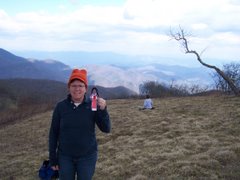Northside Middle School
Roanoke, VA
2015 TTEC Cohort
Looking back over the last few months, and the final group meeting in Damascus, Va.; I have one final reflection. However, it is not the last time I will reflect by myself, with my peers, or my students. It is the vision of the future.
The process of digesting the vast information In the TTEC program will be ongoing over the next months, and years. I want to use the strategies, ideas, and projects in my math class; however, I have had to settle for “baby steps” using only portions of activities that connect directly to the curriculum set forth by my employer. Have I been disappointed by my work and attempts to connect my students to the Appalachian Trail? Yes, but I see that it’s an ongoing process. Do I still have plans to use the things I have seen and experienced? Yes, but again the plan must take place little by little. The process for the future is don’t give up, keep trying and doing. When the students start to see the connections we give them to “places” near them, they start to value their own observations and reflections.
However, the vision that I see for the future is not only in my classroom, but in the school and school systems. We have connected to places as a group of educators. Now, we need to keep that connectedness we feel at our excursions to help each other and those who become interested in what we are doing. My challenge is this: keep in contact using social media and the internet, it’s easy enough and we already do it with our other “social circles”. I see in the reflection of my TTEC experience is that we need to keep our groups going informally. Not only do we help each other with ideas, activities, and work; but the social and moral support is out of this world in helping fuel the flame of placed based learning.
It’s a simple enough idea, but will we take this challenge? That is up to you, but as for me, I will continue to try.
Looking back over the last few months, and the final group meeting in Damascus, Va.; I have one final reflection. However, it is not the last time I will reflect by myself, with my peers, or my students. It is the vision of the future.
The process of digesting the vast information In the TTEC program will be ongoing over the next months, and years. I want to use the strategies, ideas, and projects in my math class; however, I have had to settle for “baby steps” using only portions of activities that connect directly to the curriculum set forth by my employer. Have I been disappointed by my work and attempts to connect my students to the Appalachian Trail? Yes, but I see that it’s an ongoing process. Do I still have plans to use the things I have seen and experienced? Yes, but again the plan must take place little by little. The process for the future is don’t give up, keep trying and doing. When the students start to see the connections we give them to “places” near them, they start to value their own observations and reflections.
However, the vision that I see for the future is not only in my classroom, but in the school and school systems. We have connected to places as a group of educators. Now, we need to keep that connectedness we feel at our excursions to help each other and those who become interested in what we are doing. My challenge is this: keep in contact using social media and the internet, it’s easy enough and we already do it with our other “social circles”. I see in the reflection of my TTEC experience is that we need to keep our groups going informally. Not only do we help each other with ideas, activities, and work; but the social and moral support is out of this world in helping fuel the flame of placed based learning.
It’s a simple enough idea, but will we take this challenge? That is up to you, but as for me, I will continue to try.













































